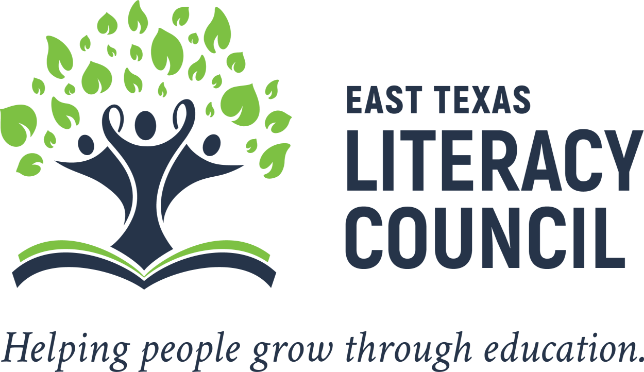The primary mission of ETLC is to address the literacy needs of the 34% of adults in Gregg County who are functionally illiterate and the increasing population of adults who are learning English as a second language (ESL). Improved literacy skills lead to better jobs and better lives for parents and their children.

Services provided through the ETLC include small group instruction and/or one-to-one tutoring through which a staff member or trained volunteer is matched with an adult student to teach them to read, write, or improve math skills.
Pre-GED and GED instruction is available to those looking to attain a High School Equivalency diploma so that they can attend community college or technical school. Pre-workplace literacy and work readiness skills are taught to young adults who desire to complete the GED.
English as a Second Language (ESL) is offered in small group and classroom settings. A fully equipped Learning Center is available to literacy and ESL students to work in various computer-based learning programs to further improve their ability to read, write, and speak English.
Mission Statement
To provide opportunities for adults in Gregg County to develop the basic literacy skills necessary to attain self-sufficiency and to function successfully in their community.
Our History
The East Texas Literacy Council (ETLC), located in Longview, Texas and serving Gregg County, was established in 1987 as a community-based 501c 3 nonprofit organization. Early Literacy Council work was done by volunteer tutors and two staff members serving 60 clients.
In 1994, ETLC opened the Learning Center with computer learning stations. In 1999, ETLC began ESL instruction to meet the needs of the growing area immigrant population.
In 2001, ETLC began providing workplace readiness instruction and workplace literacy programs to meet the increased literacy needs in the workplace.
Today, through community support and grants, the ETLC has been able to increase its capacity to serve adult learners with pre-GED and GED instruction.
Statistics
https://proliteracy.org/Adult-Literacy-Facts
Adult literacy can change everything. Health. Gender equality. Poverty. Every important social issue is impacted by low literacy. When individuals learn how to read, write, do basic math, and use computers, they have the power to lift themselves out of poverty, lower health care costs, find and keep sustainable employment, and ultimately change their lives.
Family Literacy
Children of parents with low literacy skills have a 72 percent chance of being at the lowest reading levels themselves.1

Poverty
Of adults with the lowest literacy levels, 43 percent live in poverty, and 70% of adult welfare recipients have low literacy levels.2
Health Literacy
An excess of $230 billion a year in health care costs is linked to low adult literacy.3
Unemployment/Workforce
Low literacy costs the U.S. at least $225 billion each year in non-productivity in the workforce, crime, and loss of tax revenue due to unemployment.4
Education
Every year, one in six young adults—more than 1.2 million—drop out of high school.5
ELL (English Language Learners)
About 50 percent of the 2 million immigrants that come to the U.S. each year lack high school education and proficient English language skills.6
Corrections
Research shows that inmates who are educated are 43 percent less likely to return to prison.7
Low literacy is a global crisis that affects all of us.
That’s why it’s so important to understand the issues and confront the facts head on. Only then can we can stand together to fight for change.
Sources
- 1. National Bureau of Economic Research (NBER)
- 2. The National Institute for Literacy
- 3. American Journal of Public Health
- 4. National Council for Adult Learning (NCAL)
- 5. National Center for Education Statistics,
- 6. Center for Immigration Studies, National Commission on Adult Literacy
- 7. U.S. Department of Justice, Rand Report: Evaluating the Effectiveness of Correctional Education

